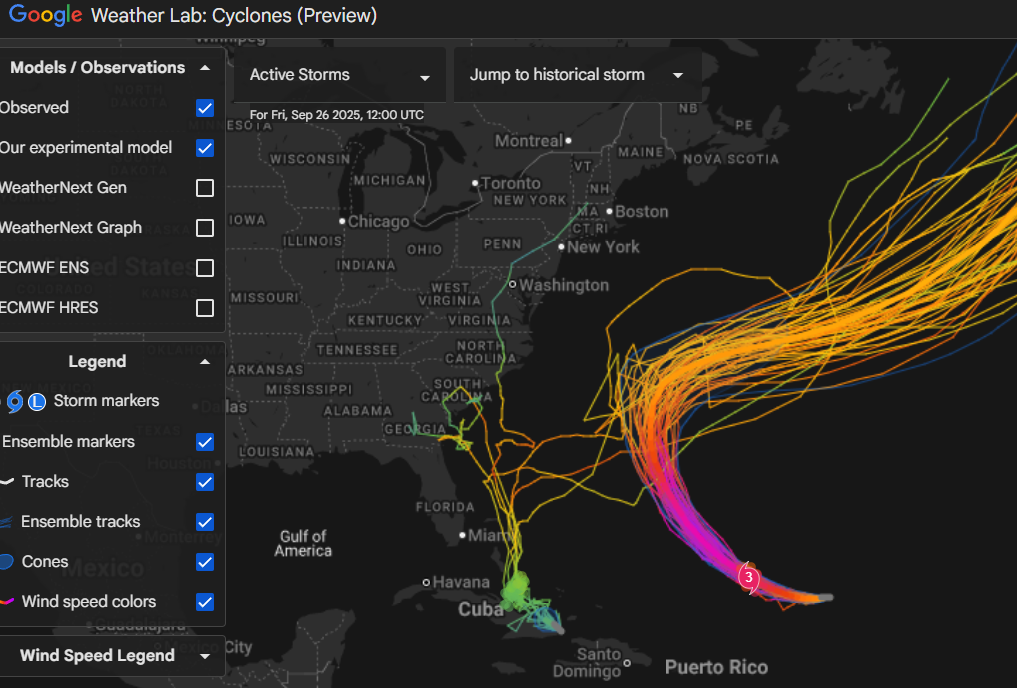Google DeepMind's AI weather forecasters
such as GraphCast and GenCast, work by using machine learning to learn patterns directly from decades of historical weather data.1 This approach fundamentally differs from traditional forecasting methods like those used by the European Centre for Medium-Range Weather Forecasts (ECMWF) or the Global Forecast System (GFS), which rely on Numerical Weather Prediction (NWP) models that solve complex, predefined physics equations.2

How DeepMind's AI Weather Forecasters Work
DeepMind's models, which are part of a family of systems called WeatherNext, use a Graph Neural Network (GNN) architecture (as seen in GraphCast) and generative AI (as seen in GenCast).3
- Data-Driven Learning: Instead of being programmed with the explicit equations of atmospheric physics, the AI models are trained on four decades of reanalysis data (like ECMWF's ERA5 dataset).4 This data combines past weather observations (satellites, radar, weather stations) with physics-based modeling to create a comprehensive, gridded record of global weather.5
- Pattern Recognition: The GNN architecture is especially effective at processing the spatially structured nature of weather data (i.e., how different points on the global grid are connected and influence each other).6 The AI learns the cause-and-effect relationships that govern how weather evolves from one state to the next over time.7
- Prediction by Iteration:
- The models take the current state of the weather (and the state from a few hours prior) as input.8
- They then predict the weather for a short time increment (e.g., 6 or 12 hours) into the future.9
- This output then becomes the new input, and the process is rolled forward in 6-hour or 12-hour steps to generate forecasts for up to 10 or 15 days in advance.10
DeepMind AI vs. Traditional Forecasting (NWP)11
The differences between the AI approach and traditional Numerical Weather Prediction (NWP)—the foundation of models like ECMWF and GFS—can be summarized as follows:
| Feature | DeepMind AI Models (e.g., GraphCast, GenCast) | Traditional NWP Models (e.g., ECMWF, GFS) | | Core Method | Data-driven machine learning (Graph Neural Networks, Generative AI) trained on historical data. | Physics-based simulation (solving fluid dynamics, thermodynamics, and other complex equations). | | Prediction Speed | Extremely fast (e.g., GenCast can generate a 15-day ensemble forecast in about eight minutes on a single AI-specialized chip). | Slow (requires hours to run on massive supercomputers with thousands of processors). | | Computational Resource | Highly efficient, running on specialized Tensor Processing Units (TPUs) or GPUs. | Resource-intensive, requiring enormous supercomputers. | | Accuracy | Shown to be more accurate than leading traditional deterministic and ensemble systems for medium-range forecasts (up to 15 days) on many key variables. | High accuracy, but the complex equations are approximations of atmospheric dynamics, which can introduce errors that magnify over time. | | Model Development | Focuses on learning patterns directly from data, making it flexible to complex, unmodeled dynamics. | Focuses on improving the resolution and physical parametrization (representing processes too small to resolve) of the governing equations. |
Key Differences in Practice
- Speed and Efficiency: The most immediate and significant difference is speed. DeepMind's models can generate forecasts in minutes, compared to the hours required by NWP supercomputers.12 This efficiency allows for faster operational use and the possibility of running much larger ensembles (multiple forecasts to gauge uncertainty).13
- Source of Knowledge: NWP is built on human knowledge of physics, while the AI models are built on patterns learned from data.14 While AI models have shown superior performance in speed and accuracy for medium-range (1–15 day) forecasts, they still rely on NWP-generated reanalysis data for their training, meaning they are not fully independent of traditional physics models.15
- Ensemble Forecasting: While traditional models like ECMWF's ENS produce an ensemble forecast (a set of possible future weather scenarios to express uncertainty), DeepMind's GenCast uses generative AI to produce high-quality ensembles much faster and has demonstrated superior skill in predicting the risks of extreme events.16
|





